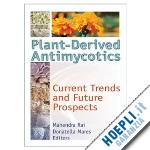An important overview of the state of the art in naturally occurring antimycotics!Here is a comprehensive and innovative examination of the antimycotic potential of essential plant oils and extracts against fungal infections affecting humans, animals, plants, and foodstuffs. Plant-Derived Antimycotics emphasizes the antimycotic activity of plants found in Central America, India, Nepal, Fiji, and China--areas rich in phyto-diversity and traditional botanical/medical knowledge.From editor M.K. Rai: “Since the inception of human civilization men have been using herbs against various mycotic infections. In the recent past, several antimycotic agents have been introduced into the market due to their rapid curative properties. Still, the quest for new antifungal agents of a fungicidal rather than fungistatic nature continues. Furthermore, there has been a dramatic increase in the new spectrum of fungal infections known as opportunistic fungal pathogens. Consequently, plant-derived antimycotics are gaining importance, being natural, cheaper, safer, eco-friendly, and within the reach of the common man.”With a distinguished list of contributors from around the world, Plant-Derived Antimycotics explores: antifungal compounds that strengthen plant-defense systems traditional herbs that have revealed their antifungal properties newer, faster methods of screening and evaluating antifungal drugs natural antimycotics derived from plants in Croatia, South America, South Africa, China, India, and Fiji the mechanism of herbal antimycotic action the diversity of antimycotic efficacy in Asteraceous and Meliaceous plants new bioactive antifungal moleculesPlant-Derived Antimycotics is an essential reference for pharmacologists, microbiologists, clinical mycologists, oncologists, immunologists, drug manufacturers, botanists and ethnobotanists, phytochemists, herbalists, and everyone searching for a natural remedy for the new spectrum of opportunistic fungal infections generated by the immunocompromising difficulties encountered by AIDS and cancer patients. Color illustrations, photographs, charts, tables, and graphs make the information easier to absorb and understand.











